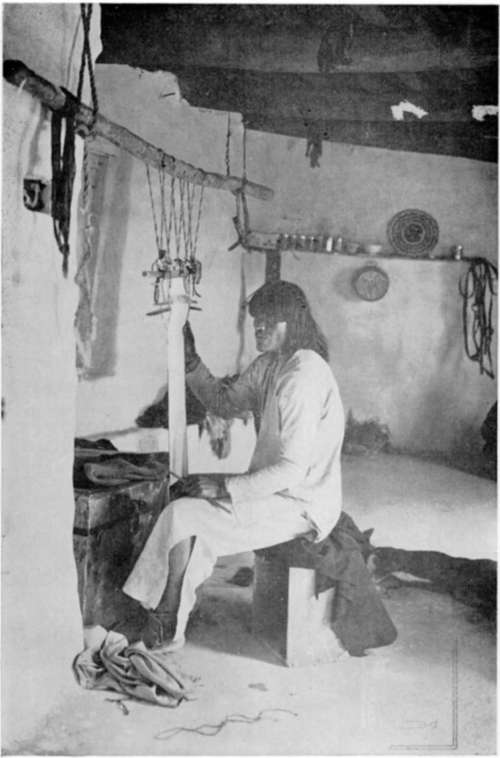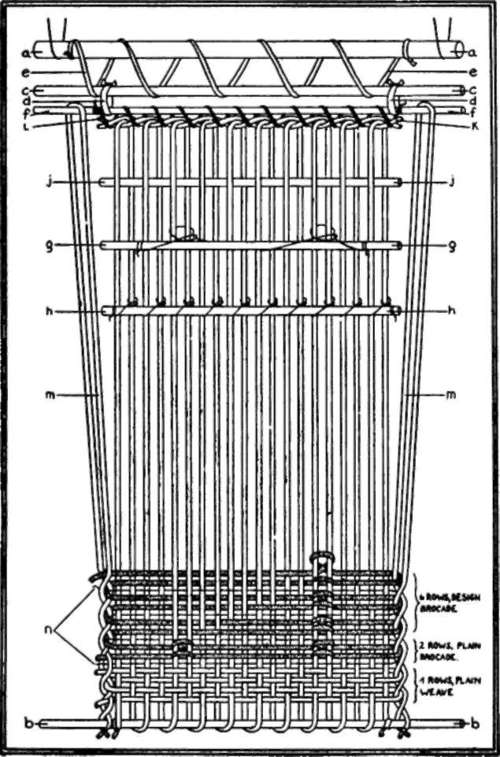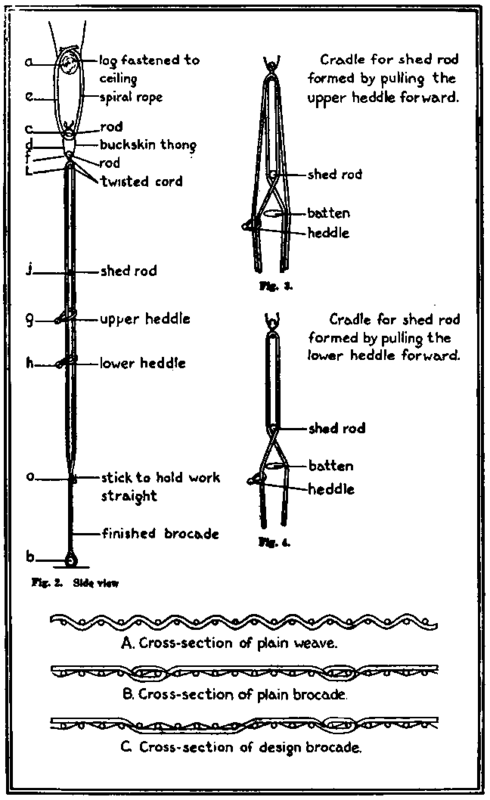Embroidery Weaving (sometimes called brocading)
Description
This section is from the book "Pueblo Crafts", by Ruth Underhill. Also available from Amazon: Pueblo Crafts.
Embroidery Weaving (sometimes called brocading)
An unusual form of weaving, practiced only by the Hopi, is found in the brilliantly patterned ends of the man's ceremonial sash. (Plate 111-34) At first sight, it looks like embroidery and, in fact, embroidery weaving seems the best name for it. Brocade, a name occasionally used, is condemned by professional weavers since the design does not show in reverse, on the wrong side, as in white man's brocade. We are faced here, as often in weaving descriptions,

Plats 111-30, Woman's belt in red and white, with design in floated warp with the fact that the terms used for European weaves do not quite fit those of American Indians.
Embroidery weaving, for instance, is unlike anything made in Europe. More than that, it is unlike any fabric from Peru. This weave, in this case, seems to be an elaboration worked out by pueblo weavers and never achieved by the workers further south. Was it suggested by Spanish fabrics which pueblo people tried to imitate on their looms? There are no signs of it in the ruins of pre-Spanish days and all examples known are made with commercial yarn. That suggests a late origin but does not prove it, so we are left guessing.
The work at present is done by Hopi men, on the edges of white cotton sashes and kilts which are to be used in ceremonies. The main part of the garment is of white cotton in plain weave which shows at the bottom in plate 111-34 and on the wrong side. At the border is a striking design in black and green wool, with touches of white. Looking at plate 111-34, you see that the outstanding thing about this decoration is the heavy vertical ribs, which run through the pattern from top to bottom. A white weaver would produce such ribs by using an extra heavy warp. The Hopi weaver uses regular cotton warp but each of his colored weft strands, instead of merely passing under a warp at the proper point, is wrapped once around, causing such warps to stand out like ribs. This wrapping needs a special heddle arrangement.
The basis of it is a blanket loom on a small scale. Plate 111-31 shows a Hopi weaver sitting at such a loom and plate 111-32 shows the loom rig in detail. Though this loom may have only 150 warps as compared with the many hundreds on a blanket loom, the warps are crossed in the same way, not tubular. This, of course, will not allow the weaving of a six-foot sash all in one piece. It is made in two pieces which are sewed together through the plain white section. The weaver in the photograph has almost finished one such half of a sash.
Plates 111-32, 33 show that this loom has a heddle h and a shed stick j as for plain weaving. Also, as in plain weaving, there are selvage strands m at each side, which are twisted, after each weft goes through, to make a strong edge. In the case of a sash, whose edges will have hard wear, there are four selvage strands at each side, instead of the usual two. So far, the loom looks like a blanket loom, shrunk to small scale. Its distinguishing feature is the extra heddle g which will produce the ribs. This heddle is so tied to the warps as to pull two forward and leave the next eight back all the way across the fabric. The weaver ties it on while rigging his loom but he will use it only for the patterned section. When this is finished, he will detach it, as the weaver in the photograph seems to have done for there only the regular heddle and shed stick are visible.

Plate 111-31. Hopi man weaving a sash on an upright loom.
The weaver begins work by putting in a few rows of white cotton weft, opening alternate sheds with heddle and shed stick in the usual way. When he is ready for the patterned section, he discards this cotton weft and uses, instead, the bright commercial wool which will do the wrapping and a thin linen tabby which will hold it in place. For the wrapping process, he pulls the extra heddle, thus bringing forward pairs of warps, at intervals of eight warps apart, all the way across the fabric. He uses his fingers to wrap the bright wool weft once around the first pair of warps. Then he carries it along in front of the eight warps which the heddle leaves back, then once around the next pair brought forward and so on. At the edge where the four selvage strands are twisted tightly together, he passes the colored weft through this selvage rope, then leaves it hanging.

Plate 111-32. Loom for ambroidery weaving.

Plate 111-33. Position of heddles In embroidery weaving.
Continue to:


